Volleyball
Volleyball ( ![]() ) is an Olympic team sport from the group of backstroke games. Two teams of six players face each other on a court divided by a net. The object of the game is to hit a ball over the net in such a way that the ball touches the ground in the opponent's half of the court or the opposing team makes a mistake. A team may touch the ball three times in a row to return it. Any block does not count for this purpose. The ball is played volleyed (hence the name of the sport) and may be touched with any part of the body, but in practice almost exclusively the hands or arms are used.
) is an Olympic team sport from the group of backstroke games. Two teams of six players face each other on a court divided by a net. The object of the game is to hit a ball over the net in such a way that the ball touches the ground in the opponent's half of the court or the opposing team makes a mistake. A team may touch the ball three times in a row to return it. Any block does not count for this purpose. The ball is played volleyed (hence the name of the sport) and may be touched with any part of the body, but in practice almost exclusively the hands or arms are used.
Volleyball originated in the United States at the end of the 19th century. The sport is now played all over the world. The world federation FIVB comprises 222 national federations and thus more members than FIFA or the United Nations. World championships and Olympic tournaments have been held since the mid-20th century. Other high-level competitions include the annual Volleyball Nations League and the Volleyball World Cup. In addition, there are the continental tournaments (for example the European Championship), the European Cup competitions for club teams as well as national championships and cup competitions.
In the early decades (mid-20th century), competitions were dominated by national and club teams from the Soviet Union, national teams from Czechoslovakia (men) and Japan (women), and club teams from Romania. At the end of the 20th century, the United States, Brazil and Italy were added as leading nations. Poland has also been successful in the men's event, and China and Cuba have won several titles in the women's event.
Despite its worldwide spread, volleyball is perceived differently in individual countries. While it is more of a fringe sport in German-speaking countries, the games in Poland are broadcast intensively in the media. There are several sports and variants that have developed from volleyball. The best-known variant is beach volleyball, which is also an Olympic sport.
_pictogram.svg.png)
Volleyball pictogram
_(3).jpg)
Volleyball game
Rules
The volleyball rules are set by the world federation FIVB. The current version of the rules was established at the 35th FIVB Congress in 2016 and has been in force since 2017.
Field
The pitch is 18 m long and 9 m wide. It is divided into two halves by the centre line and the net, so that each team plays on one half of the 9m by 9m pitch. Three metres from the net is another line delineating the attacking zone. To the left and right are the sidelines and at the far end is the baseline. All lines of a volleyball court are 5 cm wide each and belong to the playing field.
The net hangs above the centre line. The top edge is 2.43 m above the floor for men, 2.24 m for women and 2.35 m for mixed. The net must be taut. It is itself one metre high and 9.5 to 10 metres wide, so that it projects 25 to 50 cm beyond the side lines of the court on each side. The square meshes of the net have a side length of 10 cm and its edges are bordered with bands. The ends of the net are attached to posts 0.5 to 1 m outside the field. Antennas are attached above the sidelines on both sides of the net. These 80 cm high flexible poles delimit the area within which the ball must be played over the net.
The playing field is surrounded on all sides by a free zone at least three metres wide, in which the ball may also be played. Above the court and the free zone there shall be a space of at least seven metres (at least 12.5 metres for international competition) free from obstructions. Behind the entire length of the baseline is the service zone, where the serve is taken.
At both ends of the net are the referees. Behind the second referee is the scribes' table (for more information on these people, see the section on "Refereeing"). Next to the scribe's table are the benches where the coaches and other team members sit. Substitute players can sit in a 3 by 3 m area in the corners next to the benches.
In competitive play, the volleyball associations in the lower leagues make fewer demands on the spatial dimensions due to the limited possibilities of many smaller clubs.
Ball
→ Main article: Volleyball (sports equipment)
The volleyball is made of leather or plastic with an air-filled rubber bladder inside. With a circumference of 65 to 67 cm and a weight of 260 to 280 grams, it is smaller and lighter than a basketball or a football. It is either brightly coloured or has a pattern of different colours. The internal pressure (overpressure) must be between 294.3 and 318.82 mbar.
The brand of the match balls is determined by the national volleyball federations for their area of responsibility. In the international field, there are several approved match balls, which differ in minor details regarding colour and material composition. The general principles regarding circumference and weight are the same for all balls.
Team
The squad of a volleyball team usually consists of twelve players, sometimes more. There is room on the score sheet for fourteen players per team. Six players are on the field at a time. The six players in the starting line-up are also known as the Starting Six. The players of a team wear the same jerseys. An exception is the libero, for whom some special rules apply (see below). One player is appointed captain of the team. After a rule change, from the beginning of 2022, the libero will also be allowed to hold this position. The captain not only leads his teammates, but is also responsible for communication with the referee and formalities such as signing the match report. In addition to supervising his team, the coach is responsible for the line-up, substitutions and time-outs, among other things. He is often assisted in his work by a co-trainer. Other officials who may sit on the bench during the match are the team doctor and the physiotherapist.
Rotation
The starting line-up of the team determines the rotation order of the players on the field (see graphic), which is valid for the duration of the respective set. The positions are numbered from the back right counterclockwise from 1 to 6. The players in positions 2, 3 and 4 are in the front zone, the others in the back zone. If a team gets the right to serve, its players rotate one position clockwise. This means, for example, that the player who was previously at position 2 at the net now moves to position 1 and becomes the server for his team. The team maintains these positions until they regain the lost serving right. Players in the front zone must always have their feet closer to the net than their counterparts in the back zone at the start of a ball change, and adjacent players must also be in the correct order. Once the ball is in play, they are free to move around the court and arrange themselves according to the tactical alignment.
Game
After the ball is put into play with the serve, each team is allowed up to three contacts with the ball before the ball must cross the net. In a typical rally, the three ball contacts are used for three components of a move. The first contact is the reception, which is used to control the ball on the defensive end. The pass (second contact) brings the ball near the net. The third contact is usually the attacking shot over the net. The other team can now try to repel the attack by blocking directly at the net. If the ball then enters the defending team's half, play continues. The block contact is not counted in the three ball contacts allowed per turn. If no block is used or if no direct block point is achieved, the team with its three ball contacts sets up a new attack.
Error
A team scores a point when it strikes the ball on the ground in the opponent's half of the court or when the opponent makes a mistake. The following errors are possible:
- Ball out: The ball falls to the ground without hitting the opponent's field. The line belongs to the field.
- Four contacts: A team touches the ball more than three times in a row. A contact in the block is not counted. This also applies to multiple block touches by one or more players. The next touch after a block may also be by a player who touched the ball immediately before in the blocking action. Except for the serve, the ball may be touched with the entire body.
- Double touch: A player touches the ball twice in direct succession. Exceptions: After the block, the same player may make the first contact with the ball and when receiving, the ball may touch several parts of the receiving player's body at the same time or in immediate succession. In practice, double contact is usually determined by the rotation of the ball.
- Ball guided: A player holds or throws the ball instead of hitting it.
- Net touch: A player touches the net. Between 2009 and 2015 there was a more liberal interpretation of this rule, according to which a net touch was only considered a fault if it affected the game.
- Fault on serve: The ball does not cross the net in the full diameter between the antennas or their imaginary extension to the hall ceiling. If a served ball touches the edge of the net when crossing the net, this is not considered a fault according to the current rules. In addition, the serving player may not take more than eight seconds for this action and he must serve before it touches the court. The opponent may not block the serve or return the ball directly while in the front zone and completely above the top of the net.
- Overreach: a player reaches over the net. Exceptions: When on the attacking stroke, contact with the ball still takes place in one's own playing area; on the block, if the opponent's build-up of play is not impeded.
- Overstepping: A player steps over the center line below the net. The player's foot touches the field of play, the sole of the foot is completely in the opponent's playing area. There does not have to be an obstruction of the opponent.
- Penetrating the opponent's space: The player penetrates the opponent's space, obstructing the opponent in the process.
- Contact with uninvolved persons or objects: The ball touches a player, coach, spectator not in play or an object outside the court. This includes the net equipment outside the antennas, the antennas themselves, and the ceiling of the hall.
- Use of aids during the stroke: A player may neither be assisted by a teammate during the stroke (e.g. take it on the shoulders) nor use any other aid (e.g. jump off the bench).
- Errors by back players: Players from the back positions block in the attacking zone. If the libero plays the ball from the front zone in the top pass, no player may play an attacking shot above the net. Back players may only play attacking shots from above the edge of the net when standing in the back zone, or jump up from the back zone. Liberos may not play any attacking strokes from above the edge of the net. The mere attempt of a block or an attack is not a fault.
- Positional error: A team must be set up according to the rotation order at the beginning of each service (see above). Whether a team is set up correctly is determined solely by the position of its players relative to each other. In addition, players are not permitted to leave the court beyond the sidelines before serving.
- Line of sight block: If one or more players stand (or move) in such a way that the opponent is not able to see the serving player and the trajectory of the ball, this is a prohibited line of sight block. Therefore, if players block the view of the person serving, the ball may not be served over those players.
Video Evidence (Challenge)
In some international competitions of the FIVB and CEV as well as in the final of the DVV Cup, video evidence has been used since 2013, also known as "challenge". If a team doubts a decision of the referee, it can have it reviewed. A challenge is possible for the question ball in the field or out as well as for block touches, net errors, antenna touches and for overruns. It must be shown immediately after the occurrence of the respective error. Each team has at least two opportunities per set to request video evidence. If it has rightly appealed, it gets another chance.
Counting method
In volleyball, the team that wins a move scores a point ("rally point system"). If the serving team commits an error, the other team receives both a point and the right to serve. Their players change positions according to the rotation order. The serving player is then the player who is in position 1 after the rotation.
A set is won when a team reaches 25 points and has at least a two-point lead. If a team does not have such a lead when it reaches 25 points, the set is extended until one team has earned a two-point lead (i.e., at least until 26:24).
To win a match, a team must win three sets ("best of five"). After each set there is a change of sides. There is a three-minute break between sets (possibly a ten-minute break after the second set). The fifth set is called a tiebreak and ends when one team reaches 15 points (with at least a two-point lead). Once a team reaches eight points, the teams switch sides.
Before the first set and again before any fifth set, the referee tosses a coin. The captain who wins the draw may choose to serve or not, or to serve on one side of the court, while the other captain makes the other decision.
In the European Cup competitions, there is an additional deciding set, the "Golden Set", which ensures a decision if each team has recorded a victory after the first and second legs.
The rally point system was introduced in 1999 to better control the duration of a match, making it more enjoyable for spectators and more beneficial for broadcasters. Previously, only the serving team could score a point. Before the rule changes, counting up to 15 points basically applied to all sets, with the first four sets being decided at the latest - that is, regardless of the lead - when one of the two teams reached 17 points. The fifth set was played to 15 points, with the set not being over until the team was two points ahead.
Time outs and substitutions
When the leading team reaches the eighth or sixteenth point, the rules provide for a one-minute technical timeout in the first four sets. In addition, both coaches may request two time-outs, each lasting 30 seconds, from the second referee per set. In the lower divisions there are usually no technical time-outs.
With the tactical time-outs the coach can influence the game. The possible reasons for such a time-out are manifold. The coach can take a time-out to calm down his team in a bad phase. He can try to give new instructions to the team, although the receptivity is limited in the short time. In addition, a timeout can be used to interrupt the flow of play in the opponent. For example, if an opposing player has hit several serves well in a row, the interruption may break his concentration.
Six substitutions are allowed per set and team. The substitute usually holds a board with the number of the player to be substituted. Multiple substitutions are also possible, where several players are substituted at the same time. Once a player has been substituted for another, he can only be substituted for that player again (return substitution). After that, the substitution quota for these two players is exhausted in this set, with the consequence that the starting player must finish the set and the substitute player must sit on the bench until the next set. He may also not be substituted for another starting player after his substitution. Regardless of these rules, the libero may be substituted in and out of the three back positions as often as desired. An exception to these rules exists in the event that a player in play is injured and cannot continue to play.
Sanctions
For "simple" rule violations (disorderly conduct), a verbal warning is given first. For further misconduct, the team of the player who committed the rule violation is formally cautioned with a yellow card. With a red card, the referee indicates a punishment. In this case, the opponent receives an additional point and the right to serve. A yellow-red card means that the player concerned is sent off (cards in one hand) or disqualified (cards in two hands). The suspension is valid for the current set, the disqualification for the entire match. In both cases, the player must be replaced immediately by a regular substitution. If the substitution is not possible, the team is declared incomplete and the opposing team wins the set. After a rule change, a disqualified player can be replaced by another player from the beginning of 2022, regardless of previous substitutions.
Until a rule change in 2013, the meanings of cards and referee signs were defined differently. At that time, a yellow card was considered a sanction that was associated with a point for the opponent, the red card caused the suspension of a player and the yellow-red card, shown together in one hand, caused disqualification.
Points and tables
In tables of national and international tournaments the number of wins, the resulting points, the sets played and the ball points are considered. Ball points are the points played within a set. For example, a team that wins a match 25:20, 25:22, 25:23 has a value of 75:65. The quotient of these numbers (75:65 = 1.154) is called the ball point quotient (BPQ).
In international competitions, in the leagues of the leading volleyball nations and (since the 2013/14 season) also in all German leagues, the three-point rule applies. A team that wins 3:0 or 3:1 receives three points, while the loser goes home empty-handed. In a match that ends 3:2 after a deciding set, there are two points for the winner and one for the loser.
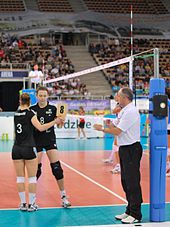
Substitution
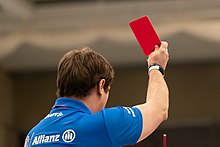
First referee shows red card
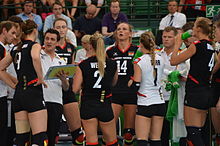
Time out for the German women's national team at the 2013 European Championship
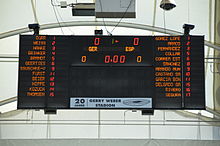
Scoreboard for a volleyball match in the Gerry Weber Stadium (more detailed explanation on the picture description page)
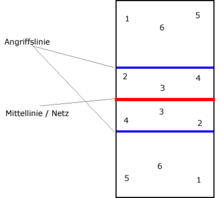
Player positions in volleyball
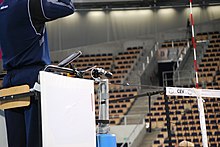
Network camera and tablet of the first referee
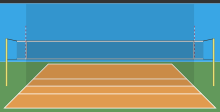
Volleyball court seen from the baseline
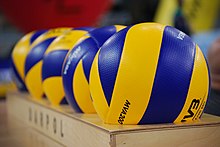
official volleyballs with FIVB logo
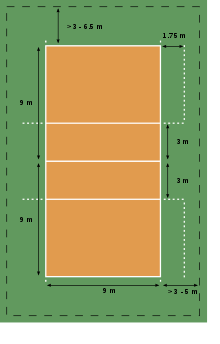
Dimensions of a volleyball court
Arbitration
The arbitration panel consists of the first and second referees, two or four linesmen and the scribe; in addition, there may be an assistant scribe. The composition of the refereeing panel and their division of duties varies according to the league level and the type of competition. While international matches are played with two referees and four linesmen, only two linesmen are used in the Bundesliga. There are also games in other competitions without linesmen or with only one referee. Junior and senior matches are often played without or with non-licensed referees. The activity of the referees is supervised by match commissions.
First referee
The first referee stands on a referee's chair at the end of the net. His horizontal field of vision must be approximately 50 cm above the net. He shall direct the play and have decision-making authority over all members of the referee panel and the teams. His decision is final once the next serve has been allowed or the set has ended. He may overrule other members of the Referee Panel if they are found to have erred. However, he must pay attention to the observations of his assistants. When asked by the team captain, he must explain his decision. He may sanction the conduct of any person entered on the match report.
The first referee releases the serve with a hand signal and whistle. If he recognizes a fault, he whistles immediately. After eye contact with his assistant and the line judges, he points out the nature of the fault and, if necessary, the player concerned with a hand signal. The first referee may have the play replayed if there is a double fault: Either both teams made a mistake at the same time, or the referee cannot tell which of the two mistakes happened first. At the discretion of the referee, a play may also be replayed for other reasons.
Before the match, the first referee gives instructions to the other members of the referee panel as well as to the scribe. He also checks the hall, the playing material (balls, net, field lines, etc.) and the players' jerseys. The home team is responsible for ensuring that spectators and other bystanders do not disturb the game and that the field is ready in time. If they fail to do so, the referee may penalize that team.
Second referee
The second referee stands at the opposite end of the net. He assists the first referee and communicates with him constantly. While the first referee (almost) exclusively observes the ball and the corresponding actions, the second referee mainly keeps an eye on the net and the centre line. He pays attention to net touches, overruns, blocking actions, obstructions of the opponent, positional errors and ball contacts. If the play does not take place there, he observes the play actions. He moves sideways and usually stands on the side of the defending team. If the second referee detects a mistake within his area of responsibility, he signals this by blowing his whistle, but first indicates the nature of the mistake and, if necessary, the player who committed the mistake. If a fault has been whistled - regardless of which referee - he remains on the side of the team which, in the opinion of the second referee, committed the fault. If the first referee has blown his whistle, but the second referee has not been able to determine a fault, he shall remain in the middle. In the case of errors outside his jurisdiction, he may indicate them to the first referee by a hand signal, but he may not stop play. In the past, the second referee repeated the hand signal of the first referee.
He also monitors the scribes, players not currently on the field, timeouts and substitutions. He receives requests for time-outs and substitutions from the coaches and rejects them if they are invalid. If they are valid, he draws the attention of the first referee with a whistle and the appropriate hand signal. The second referee thus has a wider remit than the first referee. Before the match, the second referee checks that the match report has been completed correctly and that the players' licences and identities are correct.
Show of hands of the referees
· 
Serve the team to the left of the referee
· 
Time out for the team to the right of the referee
· 
Substitution
· 
End of record
· 
Ball "off
· 
Double contact
· 
Ball touched
The two referees use hand signals defined in the official rules to indicate their decisions. They are listed in the following table according to their order in the rulebook. The first referee can show any of the hand signals, the second only some of them.
| Decision | Characters | SR * |
| Impact released | extend arm sideways and then bend arm in front of upper body in direction of impact | 1 |
| serving team | point with an outstretched arm to the side of the corresponding team | 1, 2 |
| Sideways | Swing arms in front of and behind the body | 1 |
| Time Out | form a T (for timeout) with both hands and then point to the requesting team | 1, 2 |
| Substitution | Rotate forearms in front of the upper body | 1, 2 |
| Incorrect behaviour | The yellow card is shown as a warning and the red card as a punishment. | 1 |
| Suspension (for the set) | The yellow and red cards are shown together in one hand. | 1 |
| Disqualification (for the match) | The yellow and red cards are shown separately with both hands. | 1 |
| End of set or match | Forearms crossed in front of the torso | 1, 2 |
| Ball not thrown up on serve | lift stretched arm with the palm facing upwards | 1 |
| Delay on impact | hold up eight fingers | 1 |
| Block error or visual block | Extend arms upwards with palms facing forward | 1, 2 |
| Position or rotation error | Move index finger horizontally in a circle | 1 |
| Ball in the field | point one's arm to the ground | 1, 2 |
| Ball off | First stretch the arms forward and then bend them backwards with the palms of the hands. | 1, 2 |
| ball guided | bend outstretched arm with the palm facing upwards | 1 |
| Double contact | raise two fingers | 1 |
| four touches of the ball | raise four fingers | 1 |
| Touching the net or hitting the net | Touch the net with the hand on the side where the error occurred. | 1, 2 |
| Spillover | Hold arm over net with palm facing downwards | 1 |
| Attack error | Bend arm and move forearm downwards | 1 |
| Crossing the center line, invalid serve | point to the corresponding line | 1, 2 |
| Double fault, repetition | fists with thumbs up | 1 |
| Ball touched before going out of bounds | hold one hand vertically, stroke the fingertips with the other hand | 1, 2 |
| Game Delay | Touching the wrist with the yellow card (warning) or red card (punishment) | 1 |
* The numbers indicate which referee may use this sign.
Linesman
The linesmen assist the two referees. In a game with four linesmen, each is responsible for one of the four outer lines of the field of play; with two linesmen, each of them watches two lines. They are each located at one corner of the field or (if there are two of them) at diagonally opposite corners. The linesmen signal to the referees with a 40 cm by 40 cm flag. The following signals are defined in the rules:
| Decision | Characters |
| Ball in the field | point the flag |
| Ball off | Hold flag vertically above head |
| Ball touched | Hold the flag with one hand vertically in front of the upper body and place the palm of the other hand over it |
| Ball crosses the net outside the antennas or touches an object outside the court. A player crosses the baseline on serve. | Wave the flag above your head with one hand and point to the antenna or the corresponding line with the other hand. |
| Decision not possible | Cross forearms in front of torso |
Recorder
The scribe and his assistant sit at the scribe's table behind the second referee. The scribe is first responsible for filling out the match report correctly. This includes line-ups, points, time-outs and penalties. In international matches, in the Bundesliga and increasingly in lower leagues, an electronic match report (e-score) is used. The scribe interrupts the game immediately after the serve if the wrong player has served (rotation error). He indicates to the referees if a coach requests a time-out or a substitution in violation of the rules. The assistant scribe operates the counter to display the current score. He also notes the libero's substitutions.
Three copies of the match report shall be drawn up, one for each team and one for the referee. The team captains, the scribe, the linesmen, the second referee and finally the first referee shall sign the document in the order named. Once a person has signed, he is no longer permitted to make any entries or changes; any further comment or correction must then be made in a separate report. If the captain wishes to protest about any matter, he must give notice to the first referee at the earliest possible time. If this is not done, the protest is void. The referee must allow the captain to enter a protest without exception, even if the protest would be inadmissible in substance.
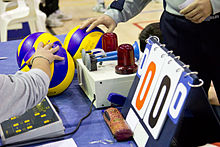
Recorder table with counter
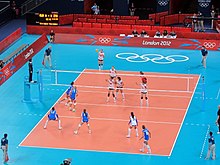
Four linesmen stand at the corners of the field of play
Questions and Answers
Q: What is volleyball?
A: Volleyball is a team sport where two teams are separated by a large net.
Q: How many players are on each side of the net?
A: Each team has six players on each side of the net.
Q: Are there any substitution players allowed?
A: Yes, each team is allowed twelve substitution players.
Q: How does the game start?
A: The game starts when the captain from each team decides which side of the court they will play on, by the toss of a coin, which also determines who will serve (hit) the ball first.
Q: What is the point of volleyball?
A: The point of volleyball is to keep the ball in the air. The ball can be played with any part of the body, with a maximum of three strokes per team.
Q: What happens if at any point during gameplay,the ball hits the floor?
A: If at any point during gameplay,the ball hits the floor, then it counts as a point for the other team.
Search within the encyclopedia

